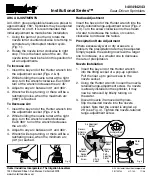
8
MicroLogix 1200 RTD/Resistance Input Module
Publication 1762-IN014B-EN-P - July 2013
RTD Wiring Considerations
Since the operating principle of the RTD module is based on the measurement of resistance, take
special care when selecting your input cable. For 2-wire or 3-wire configurations, select a cable
that has a consistent impedance throughout its entire length.
When using a 3-wire configuration, the module compensates for resistance error due to lead wire
length. For example, in a 3-wire configuration, the module reads the resistance due to the length
of one of the wires and assumes that the resistance of the other wire is equal. If the resistances of
the individual lead wires are much different, an error may exist. The closer the resistance values
are to each other, the greater the amount of error is eliminated.
To insure that the lead values match as closely as possible:
•
Keep lead resistance as small as possible and less than 25
Ω .
•
Use quality cable that has a small tolerance impedance rating.
•
Use a heavy-gauge lead wire which has less resistance per foot.
Configuration
Recommended Cable
2-wire
Belden™ 9501 or equivalent
3-wire — less than 30.48 m (100ft.)
Belden™ 9533 or equivalent
3-wire — greater than 30.48 m (100 ft.) or high humidity conditions
Belden™ 83503 or equivalent
IMPORTANT
The RTD module requires three wires to compensate for lead resistance
error. We recommend that you do not use 2-wire RTDs if long cable runs
are required, as it reduces the accuracy of the system. However, if a
two-wire configuration is required, reduce the effect of the lead wire
resistance by using a lower gauge wire for the cable (for example, use
AWG #16 instead of AWG #24). The module’s terminal block accepts
two AWG #14 gauge wires.
IMPORTANT
To ensure temperature or resistance value accuracy, the resistance
difference of the cable lead wires must be equal to or less than 0.01
Ω .








































